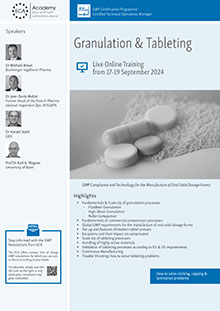Impact of the Annex 1 Revision on Pharmaceutical Water

Recommendation
17-19 September 2024
GMP Compliance and Technology for the Manufacture of Oral Solid Dosage Forms
The long-awaited draft of the new Annex 1 was published in December 2017. Besides mainly contents concerning sterile production, it also contains various updates on the manufacturing and distribution of water to be used in pharmaceutical production.
In the new Annex 1, pharmaceutical water has gained its own subsection with altogether 10 paragraphs (7.7 to 7.16). The currently applicable Annex 1 contains only two: 59 & 72.
A significant update is the reference to cold WFI (water for injection) and WFI produced by non-distillation methods. Since April 2017, the European Pharmacopoeia has been permitting the production of WFI by methods other than distillation. After the EMA published a Q&A paper on this issue in summer 2017, the expectations were high for the Annex 1 draft since the EMA paper left several major questions unanswered. Sadly, the new Annex 1 draft does not rectify that fact. However, nanofiltration and ultrafiltration are named as purification steps after the final RO membrane. Reverse osmosis alone therefore seems to be considered insufficient as a purification step.
The general requirement for water systems to be designed in a way that minimises the risk of a microbial contamination has remained the same. Water systems must be validated; what is new is the explicit requirement for consideration of seasonal influences. This, however, has been state of the art for many years and is covered by the three phase model for validating a water system (see FDA - "Inspection of High Purity Water Systems").
Other new additions are the requirement for turbulent water flow (7.10) and notes on avoiding dead legs as well as on the sloping of piping (7.11). A note about vent filters, a frequent point of discussion during inspections, can now be found in 7.12.
The requirement for a "worst case" sample point is also worth mentioning. In general, all sampling points should be considered in the sampling plan. The so-called worst case sample point, e.g. at the end of a distribution loop return, is to be sampled every time water is extracted for manufacturing. The explicit requirement for continuous monitoring ("Total Organic Carbon" (TOC) or conductivity) for all WFI systems is also new. Up to now, this was also possible offline (through sampling).
On the EU Commission's official website you will find the complete Annex 1 draft.
Related GMP News
GMP Conferences by Topics
- General Quality Assurance and GMP Compliance Topics
- Hygiene
- General Microbiology Topics
- Regulatory Affairs
- Development
- General Analytics Topics
- Good Distribution Practice
- Sterile Manufacturing
- Computer Validation
- General Qualification/Validation Topics
- General Engineering Topics
- APIs/Excipients
- GMP Basic Training Courses
- Medical Devices and Combination Products
- Packaging and Packaging Material
- Data Integrity
- Qualified Person (QP)
- GMP Auditing
- Documentation
- Cleaning Validation
- General IT Compliance Topics
- Impurities
- OOS / OOE / OOT
- Material Testing
- Validation of Analytical Methods
- Analytical Instrument Qualification
- Stability Testing
- Microbiological Testing
- Technology
- General Manufacturing Topics
- Solid Dosage Forms/Semi-Solid Dosage Forms
- Biotechnology/Blood/ATMP
- Herbal Drug Products/Cannabis/Radiopharmaceuticals
- Others




